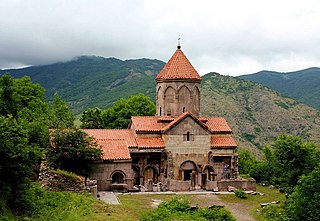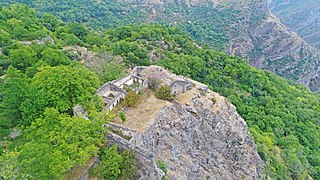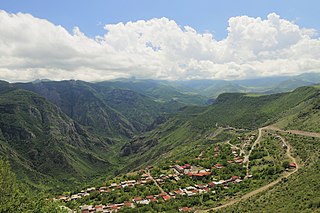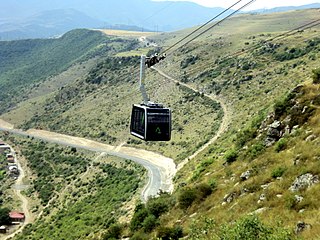
Syunik is the southernmost province of Armenia. It is bordered by the Vayots Dzor Province to the north, Azerbaijan's Nakhchivan Autonomous Republic exclave to the west, Azerbaijan to the east, and Iran to the south. Its capital and largest city is the town of Kapan. The Statistical Committee of Armenia reported its population was 141,771 in the 2011 census, down from 152,684 at the 2001 census.

Noravank is a 13th-century Armenian monastery, located 122 km from Yerevan in a narrow gorge made by the Amaghu River, near the town of Yeghegnadzor in Armenia. The gorge is known for its tall, sheer, brick-red cliffs, directly across from the monastery. The monastery is best known for its two-storey Surb Astvatsatsin Church, which grants access to the second floor by way of a narrow stone-made staircase jutting out from the face of building.

Armenian architecture comprises architectural works with an aesthetic or historical connection to the Armenian people. It is difficult to situate this architectural style within precise geographical or chronological limits, but many of its monuments were created in the regions of historical Armenia, the Armenian Highlands. The greatest achievement of Armenian architecture is generally agreed to be its medieval churches and seventh century churches, though there are different opinions precisely in which respects.

A hermitage most authentically refers to a place where a hermit lives in seclusion from the world, or a building or settlement where a person or a group of people lived religiously, in seclusion. Particularly as a name or part of the name of properties its meaning is often imprecise, harking to a distant period of local history, components of the building material, or recalling any former sanctuary or holy place. Secondary churches or establishments run from a monastery were often called "hermitages".

The Tatev Monastery is a 9th-century Armenian Apostolic Christian monastery located on a large basalt plateau near the village of Tatev in the Syunik Province in southeastern Armenia. The term "Tatev" usually refers to the monastery. The monastic ensemble stands on the edge of a deep gorge of the Vorotan River. Tatev is known as the bishopric seat of Syunik and played a significant role in the history of the region as a center of economic, political, spiritual and cultural activity.

Shinuhayr is a village in the Tatev Municipality of the Syunik Province in Armenia, 9 km south of Goris, on the left bank of the Vorotan River, on the plateau, about 1500 meters above sea level. The distance from the province center of Kapan is about 68 km.

Tegh is a village and the center of the Tegh Municipality of the Syunik Province in Armenia. Tegh is the last village on the Goris-Stepanakert Highway before passing the border with Azerbaijan.

Halidzor is a village in the Tatev Municipality of the Syunik Province in Armenia.

Khot is a village in the Tatev Municipality of the Syunik Province in Armenia. It is located on the left side of the Vorotan river, 67 kilometers from the regional center of Kapan. On the cliffs below Khot are the ruins of Hin Khot, the previous location of the village until the 1970s.

Tatev is a village and the center of the Tatev Municipality of the Syunik Province in Armenia. The village is home to the 9th-century Tatev Monastery, and hosts a station of the Wings of Tatev; the world's longest non-stop double track aerial tramway.

The Great Hermitage of Tatev is a 17th-century Armenian monastery located in the Vorotan river valley in the Syunik Province of Armenia.

Vorotnavank is a monastic complex located along a ridge overlooking the Vorotan gorge, between the villages of Vaghatin and Vorotan, about 14 km east of Sisian in the Syunik Province of Armenia. The complex is surrounded by a high stone wall for defense against foreign invasions and once housed workshops, stores, a seminary, resort, cemetery and an alms-house. A pillar stood in the yard of the monastery symbolizing that there were monks entering into religious service and kings inaugurated at this location. Hovhan Vorotnetsi (1315-1398), an Armenian medieval philosopher and theologian as well as the founder of Tatev Vardapetaran University lived and worked at the monastery.

Wings of Tatev is a 5.7 km (3.5 mi) cableway between Halidzor and the Tatev monastery in Armenia. It is the longest reversible aerial tramway built in only one section, and holds the record for Longest non-stop double track cable car. Construction was finished on 16 October 2010.

The Vorotan Cascade, or the ContourGlobal Hydro Cascade, is a cascade on the Vorotan River in Syunik Province, Armenia. It was built to produce hydroelectric power and provide irrigation water. The Vorotan Cascade consists of three hydroelectric power plants and five reservoirs with a combined installed capacity of 404.2 MW. It is one of the main power generation complexes in Armenia.

Hripsime Djanpoladian was an archaeologist and epigrapher originally from Armenia.

Akob Aghi khachkar is a khachkar located just northeast of the village of Hayravank along the southwest shores of Lake Sevan in the Gegharkunik Province of Armenia. It lies in front of the western wall of the Hayravank Monastery complex, on the pedestal; the upper left corner is broken. It is included in the state list of immovable monuments of history and culture of Armenia (5.59/1.1.3.5)։ The khachkar was created by Akob, a 16th-century Armenian sculptor, maker of khachkars and tombstones.
Armenian medieval sculptures are sculptures created in the medieval period. They are most present on or in churches, martyries, and free-standing monuments, such as four-sided stelae and khachkars (crossstones). The popularity of sculpture in the Armenian medieval art was due to midis- a three-layer layout of stones, when two rows of hewn stones were joined with lime mortar, and the surface got an artistic treatment.

St Minas is a 17th-century Armenian Apostolic Christian church located on the left bank of Vorotan river 3 km to the South-West the village of Halidzor, in the center of the Old Halidzor village in the Syunik Province in southeastern Armenia.

Saint Stepanos Church is a 17th-century three-nave structure located in the Syunik Province of southeastern Armenia, situated 1.7 kilometers southeast of Shinuhayr village, in the center of Old Shinuhair village, Syunik Province. It is part of the landscape approximately 27.7 km to east of the Sisian/Shaki turnoff along the Sisian-Goris highway.


















